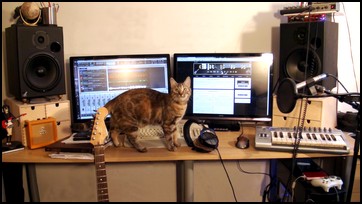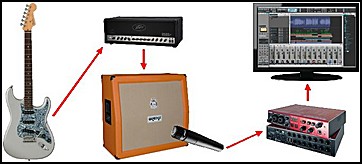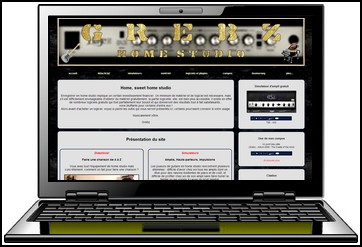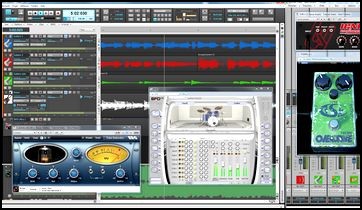

? | Homepage



Welcome to my website dedicated to home studio recording!
For years, I’ve been composing, recording, and mixing my own music. This site was born from the desire to share that experience with you.
Creating computer-assisted music doesn’t necessarily require a big budget. Sure, a minimum amount of gear is essential, but when it comes to software, there’s something for every need and every price point (including free options), whether you're looking for recording software (DAWs), effects, or virtual instruments.
On this site, you’ll find a complete tutorial on mixing a track from start to finish, advice on choosing the right equipment, an overview of the main DAWs, and a section dedicated to amp simulators (both free and paid) for guitar players.
And if you're curious, I also invite you to discover my own compositions, entirely produced in a home studio with limited resources.
Enjoy your visit, and most importantly, enjoy making music!
Grebz









I wrote my first pieces of music on a Commodore Amiga computer back in 1988.

Today, I compose in a Pop-Rock style, with forays into other genres, including orchestral and electronic music. My main goal is to enjoy the process, and if others enjoy listening too, then I’ve succeeded.
I also compose music for theatre plays.



Messages page # 1 2 3 4 5 6 7 8 9 10 11 12 13 14 15 16 17 18 19 20 21 22 23 24 25 26 27 28 29 30 31 32 33 34 35

Nico
le 16/03/2020 à 01h12
Bonjour,
J'ai essayé de me créer des IR avec Voxengo Deconvolver mais je n'obtiens que des fichiers de 1K qui sont vides.
Avez-vous une idée du problème ?
Merci par avance.

Peekup
le 22/02/2020 à 08h47
Bonjour, j'ai testé récemment une simu d'ampli. Il me semble qu'on pouvait changer le skin des amplis (skaï revêtement, boutons contrôle).sauriez vous me dire le nom de cette simu ?
merci d'avance et félicitations pour le site, une vraie mine d'or.
Thierry

billynilly
le 18/01/2020 à 18h08
Whatever happened to the Cranked AC plugin? I've been looking all over for it but can't find it anywhere.
* * * * * * * * * * * * * * * *
Sorry, I never heard of this plugin. If it's an old plugin, chances are it's also a 32-bit plugin, which may not work properly on modern systems, but anyway I couldn't find it either.
Grebz

Kovrm
le 12/01/2020 à 23h06
So the chain goes:
DAW > Audio Interface Out > Amp > Speaker > Mic > DAW
This is correct based on my understanding from what I've read, and the few videos I've watch on creating IRs. My question, then, is when I plug into the Amp I've seen people say plug your Interface out into the FX return, but you say the guitar cable jack. What is the purpose in doing one or the other?
Side questions:
What channel should my amp be on? I'm assuming the clean channel.
What should my Amp settings be (EQ, Gain, Channel Volume, Presence, Master Volume)? I can't find a clear answer anywhere.
* * * * * * * * * * * * * * * *
Hello,
About plugging into the FX return or the guitar jack, I don’t know. Actually, the amps I’ve used myself to make IRs don’t have any FX return, so I didn’t have a choice and had to plug into the guitar jack. I guess there’s no harm trying both (not at the same time!) and comparing if you have that possibility. Chances are there’s not much of a difference, but again, I may be wrong as I have not tried this myself.
About the choice of a channel, and the settings: the channel doesn’t actually matter. You’re not capturing the amp sound, but the speaker sound.
From what I’ve experienced, the EQ and Presence should be neutral, the gain/saturation should not be engaged (or set to a level where no distorsion can be heard). As for the volume, set it to a level that’s high enough for your microphone to be able to pick up a good signal (no need to record higher than -6 dB, by the way, give your signal a bit of headroom).
But you should also be careful not to set it too loud to protect your own ears. It doesn’t need to be pushed too high. I think a level high enough to cover your own conversational voice should be enough. I tried various volume levels, and it did not affect the results notably. I did not get better results with very high levels than with normal, humanely bearable levels. Don’t set it too low, though, because it’s better if your speaker does move some air.
Experiment, try different amp settings and see whether that changes the results.
Grebz

William
le 20/10/2019 à 17h06
Hey, I downloaded the plug-in and extracted it. Then put it in the plugin folder but it is not working. C:|Program Files|Common Files|Avid|Audio|Plug-Ins. Would this be the right steps? Please let me know thanks!
* * * * * * * * * * * * * * * *
As you explained it to me by e-mail, you were using Pro Tools First, which doesn't support third party plugins. The solution is then to either upgrade to a paid version of Pro Tools, or use another free DAW, such as Cakewalk by Bandlab (Windows only), or use Reaper, which is not free, but can be used freely without constraints. These DAWs do support third party plugins.
Grebz
